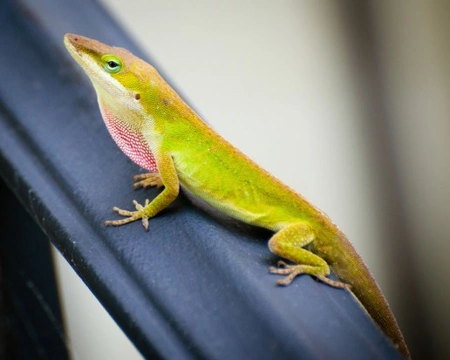
What is an Anole?
The Anole is a lizard common to the South Eastern United States and parts of the Caribbean. The Anole belongs to the sub-family of lizards known as Polychrotidae which themselves are part of the family Iguanidae.The Anole has the ability to change colour which has earned it the nickname the American Chameleon. They can also run vertically up walls which gets them confused with Geckos, however they are not related to either and are actually closer to the Iguana.
Characteristics and habitat
As well as being found in the Southern United States and the Caribbean, the Anole also populates other parts of the Western world. The majority of Anoles are a distinctive green colour and have the ability to change colour to suit their moods and surroundings which means they are commonly mistaken for chameleons.The Anole is an extremely widespread, diverse and plentiful family of lizard with over 370 species known to science. Currently the United States is home to the Jamaican Giant, Brown, Knight and Green Anoles although certain species such as the Cuban Brown are pushing some native species farther North. As a sub-arboreal lizard, Anoles live in 3m-6m off the ground in trees and shrubs but can also live in walls, fences and bushes. It has been observed that when green and brown Anoles live in the same territory, the brown species inhabit the lower branches of the shrubs and bushes, while the green Anoles live much higher up. All species of Anole in the US apart from the native green Anole have been brought in as eggs in imported plants. While all Anoles have the ability to change colour, the extent to which they can change their ‘clothes’ differs from species to species. For example, the green Anole can transform itself from a bright green to a dull brown, while some species such as the Cuban brown can only change shade and occasionally the patterns on its back.
Size & Shape
The Anole ranges between 3”-7” in length, with some types such as the knight Anole reaching up to 12” in length. Some male knight Anoles have been known to grow to 20” in length.The Anole diet comprises live insects and moths, spiders and crickets are the usual prey. As opportunistic feeders Anoles will attempt to eat anything they feel might make a tasty meal. For captive Anoles the most common food is live crickets that can be bought easily from any pet shop.Anoles can live for a relatively long time – usually between four and eight years, and even captive wild Anoles can live for many years if cared for properly. Indeed, if an Anole is given the correct environment in which to live it is not unknown for them to reach up to 14 years of age. Anoles are readily identifiable – they have a dewlap which is constructed of erectile tissue and their toes have areas that allow them to stick to lots of different surfaces. Like some other species of lizard, the Anole has the ability to break off its tail of it’s caught by a predator. The tail will continue to move for some minutes following detachment thus confusing the other animal and allowing the Anole to escape.
Breeding
The breeding season for Anoles starts in late spring and lasts for several months. In order to attract a female, the males employ a head-bobbing stance and they extend their dewlap. Females lay eggs in leaf litter and may lay more than one clutch during the mating season. Interestingly, Anoles that have remained in isolation for millions of years and have hardly evolved during that time are able to reproduce with each other. The Anole also displays sexual dimorphism, which means that the separate genders can be easily identified by the naked eye. For example in green Anoles the female bears a pale stripe down her back. Similarly the female brown Anole has a paler dorsal stripe which is slightly wider than that of the green Anole with slightly less defined edges. While males can have the stripe, and females can have a dewlap, these are always smaller and less defined.
Territory
Although their chosen territories are quite small – usually no more than three square yards – they usually live in colonies of around seven animals and can be extremely territorial. This small habitat is usually made up of very defined areas with a basking area, a shady area, a high lookout and always a hideout. Anoles will not tolerate strangers in their territory and males will perform a ritual ‘dance’ involving raising its body up and down, often while hissing and fanning its dewlap. If this is not enough to deter the intruder a fight will ensue, with both animals attacking each other’s tails. Whoever loses leaves – even if this is the Anole from the established territory.
Anoles as Pest Control
Anoles are very useful as pest control when they live in close proximity to humans. As they like to eat live insects and invertebrates they will keep populations of spiders and cockroaches down to tolerable levels and will also keep populations of other insects in check.As they are quite an aggressive lizard the Anole, if picked up by a human, will bite and removing from them from the skin can take some effort although they rarely draw blood or cause injury.



